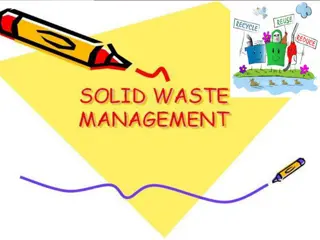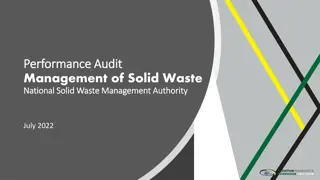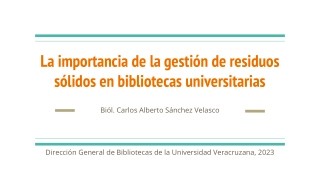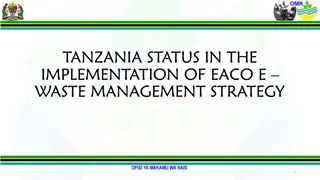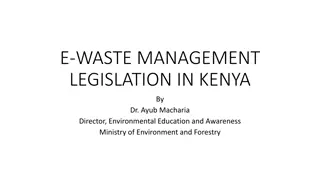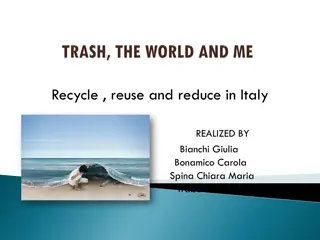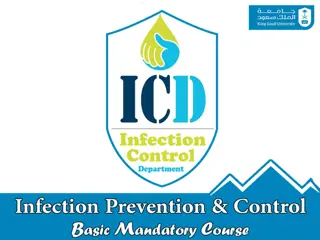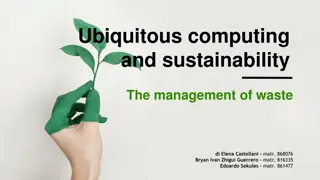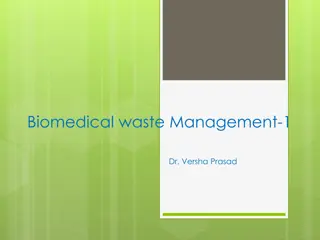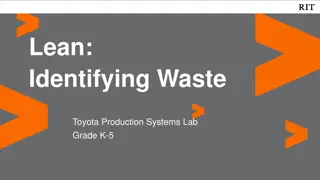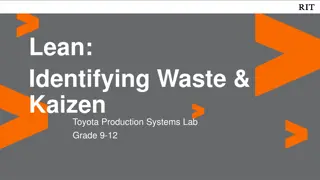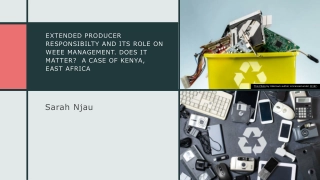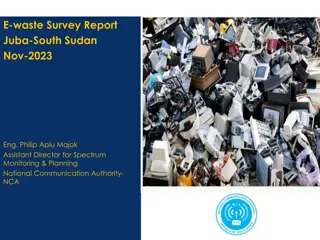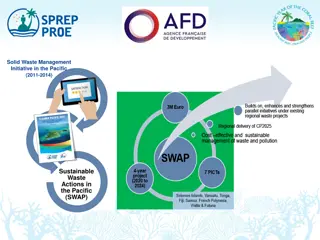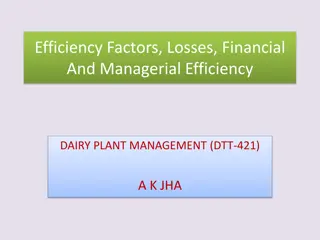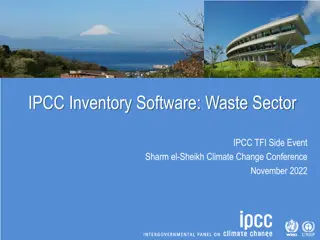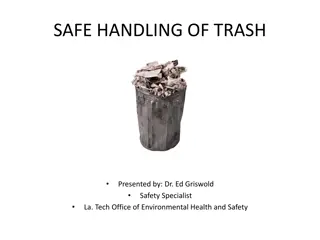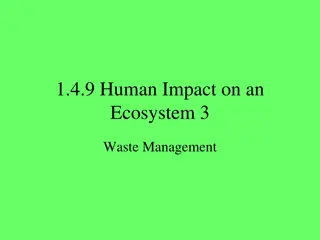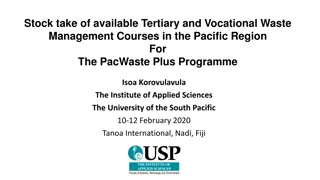Optimizing Industrial Waste Management for Resource Efficiency
Meeting the growing demand for new products while reducing environmental impact calls for resource optimization in industrial processes. This workshop delves into industrial symbiosis, circular economy, and cost-effective waste management techniques that emphasize internal recovery and recycling practices. Explore strategies to minimize waste disposal costs and enhance sustainability.
- Industrial Waste Management
- Circular Economy
- Resource Efficiency
- Waste Recycling
- Sustainable Practices
Uploaded on Jul 13, 2024 | 0 Views
Download Presentation

Please find below an Image/Link to download the presentation.
The content on the website is provided AS IS for your information and personal use only. It may not be sold, licensed, or shared on other websites without obtaining consent from the author. Download presentation by click this link. If you encounter any issues during the download, it is possible that the publisher has removed the file from their server.
E N D
Presentation Transcript
Ministry of Industrial Development, SMEs and Cooperatives INCEPTION WORKSHOPon Industrial Waste Management: Cost Structure Review INDUSTRIAL WASTE MANAGEMENT - INDUSTRIAL SYMBIOSIS AND CIRCULAR ECONOMY Dr. S. TUNESI, International Consultant UNIDO Dr. D. SURROOP, National Consultant UNIDO 4 February 2020
INTRODUCTION There have been an increasing demand of basic human needs and this demand has kept on increasing with development and improvement in standard of living There are a high demand of new and technological products that are required to maintain the standard of living This has increased the requirement of resources to manufacture those products
The past decades have been marked by increased in use of resources (raw materials) and this has given rise to increase in prices of resources, fluctuations in prices of oil There has been an increasing release of greenhouse gases which is contributing to global warming With environmental problems combined with increase in prices of resources, there is an urgent need to optimize in the resources that are used. This is where resource efficiency becomes important
INDUSTRIAL PROCESSES Industrial processes involve the different unit operations where raw materials are fed in the first unit operation and product is removed from the last unit operation. A process is basically is an input output analysis of an industry
Raw materials Industrial Processes Product Utilities
Emission Raw materials Product Industrial Processes Utilities Wastewater Solid waste
It can be recovered/recycled internally. For example: the heat from hot wastewater can be recovered prior to treatment/discharge Heat from flue gas can be recovered Neutralization of wastewater having high pH (alkali) by flue gas having high SOx (burning of HFO) Treated wastewater can be used for irrigation Although many actions are taken internally, yet there are waste that are still released/discharged The disposal/treatment cost of these waste might be significant.
INDUSTRIAL SUSTAINABILITY Countries like Mauritius do not have natural resources or have limited natural resources. Therefore, these countries are required to make additional effort compared to those that have available resources. With increase in the prices of the natural resources, industries are required to look at other alternatives to sustain their existence. This does not stop at the production lines and making profit, but it goes well beyond this. In fact, it must encompass the surrounding environment and take social aspects into considerations.
INDUSTRIAL SUSTAINABILITY This means that producing more with the same raw material (resources) if not less and reducing the release of waste and emission. It implies to optimize the process such that waste/losses in resources (raw material, energy or any other inputs) are reduced while converting the same into products. This is also called Industrial Sustainability. Industrial Sustainability cannot be achieved without Industrial Symbiosis
INDUSTRIAL SYMBIOSIS Traditional perspective of making business (profits); Product Raw materials Industrial Processes
Industrial symbiosis steers businesses away from traditionally linear production systems where natural resources are processed to generate products and waste is discarded as a spent resource.
INDUSTRIAL SYMBIOSIS The principle of industrial symbiosis is very simple. It states that any output (by-products or waste) from an industrial process, other than the product, can be a useful input (raw material) to another industrial process.
INDUSTRIAL SYMBIOSIS New approach Emission Raw materials Product Industrial Processes Utilities Wastewater Another Industry New Product Solid waste
Instead , industrial symbiosis helps businesses move towards more efficient circular systems by closing loops to make better use of materials, energy, water, waste and by products. Industrial symbiosis can be applied by businesses of all sizes and all sectors and to all resources.
Product Company A Resource Waste
Product Company A Resource Waste Product Company B Resource Waste Company C Product Resource
INDUSTRIAL SYMBIOSIS Waste that cannot be recovered internally can be sent to another industry It will also provide another industry raw material which can be cheaper. The generating firms can sell the waste instead of spending huge amount of money in disposal and the receiving industry can purchase raw materials at a cheaper price. This will give rise to business opportunities. This will help in job creation.
INDUSTRIAL SYMBIOSIS In order to have industrial symbiosis, there is need for at least two companies, from different sectors, to undertake mutually beneficial business transactions driven primarily through commercial gain Industrial symbiosis is an arrangement/collaboration between two or more companies in which the wastes or by-products of one become the raw materials for another. Industrial symbiosis enable to gain economic benefit (profit), environmental benefits and social. Industries realize industrial symbiosis not only through the reuse of materials, energy, water or by-products, but also by better utilisation of assets, services, logistics and information
INDUSTRIAL SYMBIOSIS Marian Chertow, a pioneer in Industrial Symbiosis, stated that Industrial symbiosis engages traditionally separate industries in a collective approach to competitive advantage involving physical exchange of materials, energy, water, and/or by products. The keys to industrial symbiosis are collaboration and the synergistic possibilities offered by geographic proximity"
BENEFITS OF INDUSTRIAL SYMBIOSIS Optimization of processes - this results in reduction in the amount of raw material required and its associated cost. Optimization of processes - this results in reduction in the amount of waste generated and its associated disposal cost. Make profits from by-products or waste
BENEFITS OF INDUSTRIAL SYMBIOSIS Extend the life span of the only landfill of the island by diverting the waste to other industrial process. This will reduce of all the environmental impacts associated with the waste. Reduce emission of greenhouse gases New business opportunities and stimulating innovation
BENEFITS OF INDUSTRIAL SYMBIOSIS ECONOMIC Increased sales and profit Competitive advantage Reduced waste management costs Reduced costs for raw materials, water and energy Reduced risk through diversification of raw material supply Added value to materials and services Business diversification Better asset utilisation Security of resource supply Demand-pull on innovation Improved perception of the company by stakeholders Increased private investment
BENEFITS OF INDUSTRIAL SYMBIOSIS ENVIRONMENTAL Reduction of pollution Reduction of carbon emissions Reduction in the use of natural resources Diversion of waste from landfill Reduction of resource/energy consumption Reduction of waste Reduction of hazardous waste
BENEFITS OF INDUSTRIAL SYMBIOSIS SOCIAL Safeguarding and creating new jobs Improving skills Creating socially acceptable waste disposal solutions Providing a better environment for the local community Demonstrating corporate social responsibility
Can we have industrial symbiosis in Mauritius?
Do we have industrial symbiosis in Mauritius?
SUGAR INDUSTRY Wate r Evaporator / Pan Boiling / Centrifugal Juice Suga r Cane Milling CO2 Bagass e Wastewate r Ethanol / Alcohol Molasse s Distillatio n Electricity / Heat Power plants Vinasse Emission s Ash
Bagass e Electricity / Heat Power plants Emission s Ash Cement Industry Cement
Clean CO2 for beverage s Processing CO2 Ethanol / Alcohol Distillatio n Molasse s Vinasse Fertilizer Plant Fertilize r
Poultry Industry Chicken Meat Wastewater Rendering Process Solid waste Flour for pet food
Fish Processing Industry Tuna Fish Wastewater Solid waste (intestine, head, bones) Process Flour Omega Oil
Textile Industry Shirts Fabric Wastewater Solid waste Wood Pallet (Plastics HDPE, Pallet) Recycling industries Plastics HDPE Recycling industries Plank Wood chips
Dr Dinesh Surroop Senior Lecturer University of Mauritius Tel: 403 7819 Email: d.surroop@uom.ac.mu












